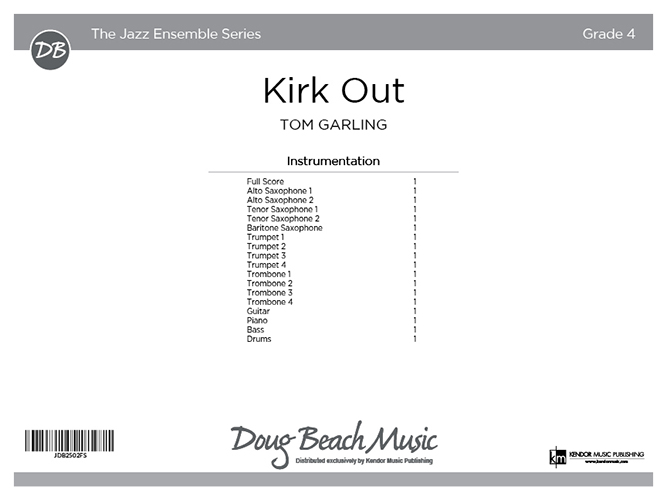You may also like…
Description
Commissioned by the Elmhurst University Jazz Band, this exciting new Tom Garling composition is a must have chart for more advanced groups. Great ensemble writing over a quasi-Brazilian feel with a funky back beat guarantees that this will be a favorite of bands and audiences alike. The chart features Trumpet, Trombone, Baritone Sax and Guitar. The perfect chart for concert or festival!
Program Notes
“Kirk Out” is influenced by the likes of Horace Silver, Miles Davis’s second great quintet (post 1964 and possibly post “Filles De Kilimanjaro), Wayne Shorter, and great Brazilian composers such as Sergio Mendez (Check out the album “Braziliero”) and Hermeto Pasqual. In addition, Clare Fischer’s music is an influence.
The feel is funk with snare drum back beat on 3 of each measure. However, the Bass and Drums should accentuate the up-beat of 4 as a pick- up to every two measure phrase, and beat one of the second measure of every two measure phrase, as indicated starting at measure 9. This will give the intended quasi-Brazilian feel with funky back beat. The Pianist should make sure to play all suggested voicings 8vb (one octave down) from where written.
The 2nd Trumpet, 2nd Trombone, Baritone Saxophone and Guitar are featured as soloists in this piece. At measure 9, the Baritone Sax and second Trombone play the bass line, and the Trumpet and Guitar play the melody in unison starting at the pick-ups to measure 17. At measure 41 (pick-ups) the four featured soloists play the melody harmonized, with Guitar and Trumpet 2 still in unison. The second Trombone and Baritone Sax should pay special attention to their harmonized notes, as they might rub against each other and sound a bit “outside”, which is the intent.
Measure 65 starts the solo section. The Bass and Drums should keep the same feel as described in the second paragraph, with some ad-lib added. The composer envisions all four soloists trading, starting with 2 choruses each, then fours when the backgrounds enter on the last time, then all at once for the last eight measures of this section. It’s important to wind down the solos in order to lead to the next section at measure 89. At measure 153, the composer envisions a slow decrescendo to almost nothing, so that the “On Cue” at measure 164 is suddenly loud and intense.
Additional information
| Weight | 0.25 lbs |
|---|---|
| Dimensions | 12 × 9 × 0.25 in |







